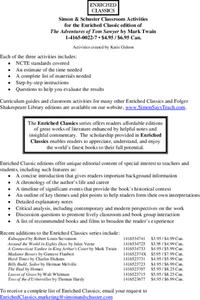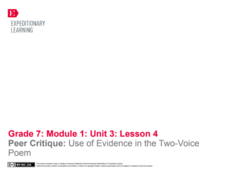Positively Autism
Pirate Vocabulary
Pirate ships and parrots, cannons and coins. Introduce learners with autism to pirate vocabulary with these pages that include an image and the printed vocabulary word.
E Reading Worksheets
Making Predictions #4
Show young readers how to use evidence from the text in an activity about making predictions. After reading five short passages, kids note what they think will happen next based on what they have read, and include the evidence that...
Curated OER
Rosencrantz and Guildenstern Are Dead: Concept Analysis
Make sure you are well-informed before embarking on a study of Rosencrantz and Guildenstern Are Dead. This resource includes an analysis of the text that a teacher can use to prepare a unit of study. It covers plot elements, themes,...
Houghton Mifflin Harcourt
Unit 6 Math Vocabulary Cards (Grade 3)
A set of 49 math vocabulary cards ranges from angle to irregular polygon to parallel lines. Each sheet contains two cards: one with the word printed in bold text and the other with the definition.
Teach Engineering
Measuring Surface Tension
How do you measure surface tension? The fifth installment of a nine-part series is an experiment where young scientists use tubes of different sizes to measure surface tension. They calculate the average and standard deviation of the...
College Board
AP® Psychology: Teaching Statistics and Research Methodology
Psychologists use statistics? Scholars investigate the research behind the methodology of statistical analysis. Using hands-on practice, case-studies, and scatterplots, they complete various tasks to understand the very roots of high...
Heather Sparks
Integer Football
They could go all, the, way...to a deeper understanding of integers with this fun math game. Using the included printable materials, young mathematicians practice adding integers and calculating absolute values as they compete in a...
Dick Blick Art Materials
“Gawu” — African-influenced Tapestry
Here's a great way to combine environmental science with art. Kids use recycled materials to create their own Gawu, a tapestry made of discards. Although designed for special education classrooms, the activity is sure to engage all...
Channel Islands Film
Cache: Lesson Plan 2 - Grades 4-6
Class members will dig this activity that has them trying their hand at recovering artifacts. Groups are assigned a section of a sandbox, carefully uncover the artifacts in their section, and then develop theories about who might...
Community High School of Vermont
Habits of the Mind
An informative one-page resource details the 16 Habits of Mind. Habits encourage positive problem-solving, self-awareness, creativity, and dedication—lifelong skills that can be used in both academic and social settings.
Education Outside
Animal Homes in the Garden
First graders journey to the school garden to examine the habitats of garden animals. Using the provided graphic organizer, kids locate and sketch a critter and its habitat before returning it to its home.
Classroom Law Project
Who are the major candidates and where do they stand?
Who were the candidates in the 2008 US Presidential election and where did they stand on important issues? Use a resource that offers an opportunity to go back in time and examine candidates and issues involved in that election year.
Illinois Elementary School Association
Improv Exercises
Here's an eight-page packet that describes 70 different improv activities to use as warm ups for drama classes.
John F. Kennedy Presidential Library & Museum
Recipe for an Inaugural Address
An inaugural address represents the first moments of a new beginning. Using John F. Kennedy's speech as a model for guided practice, groups examine the ingredients of an inaugural address. Individuals then repeat the analysis...
Simon & Schuster
Classroom Activities for The Adventures of Tom Sawyer by Mark Twain
A 16-page packet includes three activities for a unit study of Mark Twain's The Adventures of Tom Sawyer. Before beginning the novel, class members identify the factors in their lives that helped create their frame of reference,...
EngageNY
Peer Critique: Use of Evidence in the Two-Voice Poem
Peer editors review critique expectations before offering feedback on each other's two-voice poems. They record their feedback on peer critique recording forms, and then begin revising their poems.
EngageNY
Drafting an Analytical Mini-Essay: Using Partner Talk and Graphic Organizers to Guide Thinking
Moving on up ... Scholars take a look at how the author of the model essay Elements of Mythology and Theme of Cronus moved up in the writing process from a graphic organizer to an essay. After walking through the writing process of the...
Curated OER
Vocabulary Building: Final-e Rule
In this recognizing words with the final-e spelling worksheet, students write the words from dictation, unscramble letters, and create sentences using the words name, home, here, like, and some. Students write fifteen answers.
Curated OER
Vocabulary Building: Fine-e Rule 2
In this recognizing words spelled with the final-e rule worksheet, students write words from dictation, unscramble letters, and create sentences using the words five, gave, take, came, and come. Students write fifteen answers.
Curated OER
Using Math To Make Decisions About Animal Habitat
In this animal habitat learning exercise, students read, analyze and solve 5 scenarios involving mathematics and animal habitats. Students work out each decision they decide as correct and write out a proposal for each one.
Curated OER
Using 4 main directions in a classroom
Students use the four directions of a compass rose to locate classroom features. In this directions lesson plan, students locate the features by identifying directions.
Curated OER
Direct, Inverse, And Joint Variation
Young scholars engage in a lesson that has them practice solving equations using multiplication and division. They practice solving problems using the properties needed and then students practice changing word problems into an equation.
Curated OER
Reading and Writing in the Right Direction
Beginning writers practice writing and reading from left to right using green and red dots. You'll need notecards with a green dot on the left side and a red dot on the right side. Do your learners understand that print moves from left...
Curated OER
Using Simple Equations To Solve Word Problems
In this math worksheet, students learn to read a word problem, write an equation, solve for the variable and write and label the answer. There are examples given at the top of the page although directions tell students to "use...























